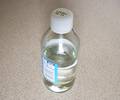Ingredients
 | An egg |  | Vinegar |
Instructions
Fill a small glass or jar with vinegar - any will work, but it might be best to use white vinegar as it is easier to see the egg.
Put an egg in, and make sure that the egg is covered with the vinegar.
Leave the egg for 24 hours.
Then have a look at the egg. Is it at all different?
Result
You should find that the shell bubbles slowly in the vinegar. After about 24 hours, there will be no shell left, and the egg will become flexible and soft.
Explanation
The eggshell is made of calcium carbonate (CaCO3) - the same mineral as limestone. If you react a carbonate with an acid, you are left with a soluble salt, carbon-dioxide, and water. The shell slowly dissolves, producing bubbles of carbon-dioxide.
Calcium Carbonate + Acetic Acid -> Calcium Acetate + Carbon-dioxide + Water
CaCO3 + 2CH3COOH -> Ca(CH3COO)2 + CO2 + H2O
So the only thing left holding the shell together is the membrane which keeps the liquid in the egg, which is flexible and stretchy, so the egg is flexible and squashy.
- Previous Margarine Planets
- Next Build your own helicopter










Comments
Cool Experiment! And the
Cool Experiment! And the "Captcha" thing at the bottom, I am a Robot. Beep Beep
Add a comment